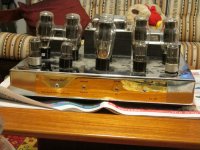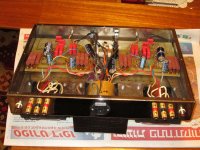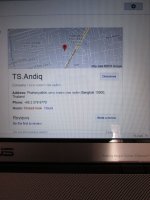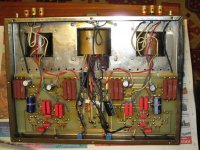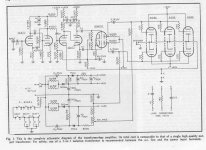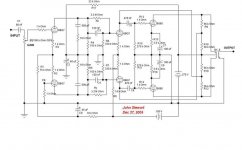Menno Vanderveen has invented a similar topo ...
It seem to me to had saw the Menno topology in an early publication.
More over, I had brought his book and in one of the worst books of Electronics I has seen. Formulas has errors, and the photo playing guitar in the garden are of no meaning in a "good" book.
Well, I haven't actually constructed that particular circuit yet so I can't say yeah, or nay, if it has value. Have you? I always take good parts from books and generally don't comment on parts that aren't so good. Are you saying the book is worthless in its entirety or do you exclude portions from your wrath?
It's always of interest to see some new ideas published. But one has to take them with some skepticism, especially when it comes to tube technology, where nearly every nook and cranny has been previously explored thoroughly.
Usually error filled books don't stand the test of time. Spangenberg's "Vacuum Tubes" book does seem to be an anomaly there, filled with math errors. I guess that's what 2nd editions are for. Good thing we have the edit function for our posts here. Probably why books are just coming out in electronic editions lately. Never finished! You pay twice to get the errors fixed.
Usually error filled books don't stand the test of time. Spangenberg's "Vacuum Tubes" book does seem to be an anomaly there, filled with math errors. I guess that's what 2nd editions are for. Good thing we have the edit function for our posts here. Probably why books are just coming out in electronic editions lately. Never finished! You pay twice to get the errors fixed.
Last edited:
The bad effects of the positive feedback from bootstrapping can be avoided by putting a CCS in place of the load resistor (ie, top of the CCS still bootstrapped to provide the high variable B+). With the correct amount of bootstrap V swing, the CCS Vac compliance only needs to handle the distortion component then (providing isolation).
The CCS load provides optimum gain for the driver then, and blocks any re-entrant distortion from the positive feedback. (mentioned this idea eons ago for fixing the Macs, but it got the usual in one ear and out the other response)
Probably in the case of the Mac it would not be a good marketing choice. They could do it for a new design but not for the classic ones like the 275.
Good idea for DIY.
45 Reports- 'The 6080 is popular in OTL amps. Except Audio Tekne I do not remember another commercial amp that uses such tube with output transformer. Probably because of its short life.'
Fixed Bias as used in OTL Amps is a death sentence for any low mu triode.
On the other hand, both 6080 & 6AS7 were used with great success by HP, Tektronix, Lambda, Kepco & others. Do we need to tell them they screwed up?
Fixed Bias as used in OTL Amps is a death sentence for any low mu triode.
On the other hand, both 6080 & 6AS7 were used with great success by HP, Tektronix, Lambda, Kepco & others. Do we need to tell them they screwed up?
45 Reports- 'The 6080 is popular in OTL amps. Except Audio Tekne I do not remember another commercial amp that uses such tube with output transformer. Probably because of its short life.'
Fixed Bias as used in OTL Amps is a death sentence for any low mu triode.
On the other hand, both 6080 & 6AS7 were used with great success by HP, Tektronix, Lambda, Kepco & others. Do we need to tell them they screwed up?
No they didn't but it doesn't change the fact that 6080 has shorter life than average. If you want to get useful 2000-3000 hours plate dissipation should be 9W or less, at least. The performance and useful life also depend on the application. Pushing these tubes to limits is not a good idea. Make an amplifier and see instead of arguing.....
What does positive fb fix? Best fb is no fb.
If you need more gain, slap ecc83 with some mosfet. >80 gain no problem, with no cathode cap. And endstage tube with twice or more plate impedance tx than "standard" value used on the internets.
Triode has fb inside, and not a bad one.
If you need more gain, slap ecc83 with some mosfet. >80 gain no problem, with no cathode cap. And endstage tube with twice or more plate impedance tx than "standard" value used on the internets.
Triode has fb inside, and not a bad one.
In my opinion the point is: There is nothing to re-invent with vacuum tubes. If the industry has decided for certain solutions rather than others it is not by mistake. Then everyone is free to do anything as DIY but it doesn't mean something new and better has been discovered....
EL84 and 6V6 are more convenient choices than 6080 EVEN in triode connection. No need for bootstrapping, equivalent linearity and efficiency to 6080 and LONGER life with much less requirements for the driver. Only advantage of 6080 is that it has two units in one bulb, so it requires only one socket but there is no space saving because is not compact at all. On the other end EL84 needs 12-15V peak drive in the worst case. The 6V6 more but it's capable of quite some power in class AB2. 6080 is not suitable for positive grid drive. Output transformers for EL84 and 6V6 pose no issues at all. Even less if there are parallel tubes.
EL84 and 6V6 are more convenient choices than 6080 EVEN in triode connection. No need for bootstrapping, equivalent linearity and efficiency to 6080 and LONGER life with much less requirements for the driver. Only advantage of 6080 is that it has two units in one bulb, so it requires only one socket but there is no space saving because is not compact at all. On the other end EL84 needs 12-15V peak drive in the worst case. The 6V6 more but it's capable of quite some power in class AB2. 6080 is not suitable for positive grid drive. Output transformers for EL84 and 6V6 pose no issues at all. Even less if there are parallel tubes.
No they didn't but it doesn't change the fact that 6080 has shorter life than average. If you want to get useful 2000-3000 hours plate dissipation should be 9W or less, at least. The performance and useful life also depend on the application. Pushing these tubes to limits is not a good idea. Make an amplifier and see instead of arguing.....
I did build, not one but several. Also did several in regulated power supplies. And an OTL using 3X 6AS7 back in the day probably before you were born. BTW, my experience with reg PS spans 1.4V to 4500V, One amp. All with or for tubes. Does that count?
Not arguing at all, just stating what I have experienced. Your opinion counts. And so does mine!
In my opinion the point is: There is nothing to re-invent with vacuum tubes. If the industry has decided for certain solutions rather than others it is not by mistake. Then everyone is free to do anything as DIY but it doesn't mean something new and better has been discovered....
EL84 and 6V6 are more convenient choices than 6080 EVEN in triode connection. No need for bootstrapping, equivalent linearity and efficiency to 6080 and LONGER life with much less requirements for the driver. Only advantage of 6080 is that it has two units in one bulb, so it requires only one socket but there is no space saving because is not compact at all. On the other end EL84 needs 12-15V peak drive in the worst case. The 6V6 more but it's capable of quite some power in class AB2. 6080 is not suitable for positive grid drive. Output transformers for EL84 and 6V6 pose no issues at all. Even less if there are parallel tubes.
Your opinion counts. But so do the opinions of others. There is strength in diversity. We don't need one leader. So I like many will try whatever comes to mind!
No they didn't but it doesn't change the fact that 6080 has shorter life than average. If you want to get useful 2000-3000 hours plate dissipation should be 9W or less, at least. The performance and useful life also depend on the application. Pushing these tubes to limits is not a good idea. Make an amplifier and see instead of arguing.....
Does your 'No they didn't' refer to HP, TEK, Lambda & Kepco? You better take another careful look. All used both 6080 & 6AS7 in quantity in the tube era. While spending my ten years in R&D I saw & worked with & on many.
Your opinion counts. But so do the opinions of others. There is strength in diversity. We don't need one leader. So I like many will try whatever comes to mind!
Sorry no leader here. You asked questions I gave my response and you pulled in HP, Tektronix,etc NONE of which has ever made an audio amplifier in my knowledge. If they did certainly was not successful. If you don't like certain answers then don't ask questions! It' as simple as that.
As I said you can do what you want but you have done nothing new. If there are not all these 6080 amps there are several good reasons....
Last edited:
Does your 'No they didn't' refer to HP, TEK, Lambda & Kepco? You better take another careful look. All used both 6080 & 6AS7 in quantity in the tube era. While spending my ten years in R&D I saw & worked with & on many.
I don't remember any successful audio amplifier sorry. If they made one it didn't survive. Most vintage amps use other tubes. Why?
No one has done it with low mu triodes because it is not needed or economy is not a priority, especially with 300B and 2A3. At least I have never seen it. A DHT is too "noble" device to use such a "vulgar" solution.🙂
The 6080 is popular in OTL amps. Except Audio Tekne I do not remember another commercial amp that uses such tube with output transformer. Probably because of its short life.
Of course, because of the low mu, everything happens on smaller scale. It doesn't give the same advantages as with pentodes. In a circuit like the McIntosh, where the gain of the output tube is reduced by a factor of 3-8 times because of the local feedback, using the bootstrap allows to keep things normal (i.e. no need for expensive drivers or additional PSU) and the Zout is still equal or better than a non-bootstrapped 300B amp. Loop fb usually makes it very low again.
And you would be wrong. Someone has done it, copied my idea for his line of amplifiers & made in Bankok. I was tracked down by one of his customers in Israel. His amp had failed. By the photos I could tell the biasing network was screwed up.
It is imperative that each triode have its own bias resister & bypass cap. This manufacturer did not do that. And a gross failure was certain. The bias resistors are not only the correct value but need to dissipate 1/2 of what each triode is dissipating (mu = 2). That is a lot of heat under the chassis. But could be done with power resistors on heat sinks to outside air. Or a bias servo.
Never say never!!
Attachments
Never heard of amplifiers made in Bankok. Never seen one in a shop. Sorry! By the way I was talking about commercial amplifiers. It doesn't change what I think. If you like it I have no problem.
The 6080/6AS7 tubes are characterised for V regulator duty, where they would likely be drawing constant current near their max DC rating. Unlike a class AB amplifier where the idle current is much lower. So no surprise that regulator tubes would have shorter lifetimes typically. OTL amps probably stress the tubes out to several times the max DC rating at signal peaks to avoid racks of tubes, so they likely suffer similar fates.
Read what I said carefully. First of all it is commercial in Bankok & SE Asia. In this case the customer was in Israel. So I guess there is some kind of distribution system. The website shows many other kinds of hifi amps. Take your pick. The fact that you or any of us did not know about this source doesn't mean it is not there. There really is life outside the developed countrys.
And I don't like it much either, this place has taken my idea & ran with it.
And your opinions you should run with, perhaps insulated from the outside world of ideas. Go go it!!
And I don't like it much either, this place has taken my idea & ran with it.
And your opinions you should run with, perhaps insulated from the outside world of ideas. Go go it!!
The 6080/6AS7 tubes are characterised for V regulator duty, where they would likely be drawing constant current near their max DC rating. Unlike a class AB amplifier where the idle current is much lower. So no surprise that regulator tubes would have shorter lifetimes typically. OTL amps probably stress the tubes out to several times the max DC rating at signal peaks to avoid racks of tubes, so they likely suffer similar fates.
If you run them too hot they won't last long. This is quite common to all tubes of the same kind. Idle current cannot be too low because it is not that linear. I have several 6AS7G/6080 types in my collection. Mint in mint boxes. Both American and European. Some have become quite expensive now, like the GEC. I might find easily someone who is willing to buy them if this "new" amplifier becomes popular. I would certainly not regret it.😀
If fact I said in my knowledge and talking of commercial amplifiers in the western world....where I live.Read what I said carefully. First of all it is commercial in Bankok & SE Asia. In this case the customer was in Israel. So I guess there is some kind of distribution system. The website shows many other kinds of hifi amps. Take your pick. The fact that you or any of us did not know about this source doesn't mean it is not there. There really is life outside the developed countrys.
And I don't like it much either, this place has taken my idea & ran with it
And your opinions you should run with, perhaps insulated from the outside world of ideas. Go go it!!
I don't like it at all and it is not worth the effort for me. I have other ideas. You are stuck on the amplifier....no problem!
Last edited:
The 6080/6AS7 tubes are characterised for V regulator duty, where they would likely be drawing constant current near their max DC rating. Unlike a class AB amplifier where the idle current is much lower. So no surprise that regulator tubes would have shorter lifetimes typically. OTL amps probably stress the tubes out to several times the max DC rating at signal peaks to avoid racks of tubes, so they likely suffer similar fates.
I built & used quite a few in regulators. One requirement that helps keep the lid on the 6080 family is something like a 100R resistor in each of the cathodes. Not the plate as it appears in some schematics. Resistor in the cathode is (mu + 1) times as effective as if it were in the plate in equalizing (sharing) plate currents.
In the TEK scopes the 6080s did not need frequent replacing, they lasted a very long time. My dayly drivers ran the gammit, 315D, 514D, 531, 541, 543, 545 & 547. We also had a true dual (not dual trace) beam monster, I think it was a 555. Could heat a house. The -ve regulator was often a 12B4.
Hard to believe, there was an in house project of a home grown hifi amp driven by some of the development guys at Palo Alto (HP). All done on there own time. I do not own one.
The OTL is a real problem. Cathode stripping, flame out & meltdown. But people still build them........and pray! The OTL I built was in Audio Engineering magazine around 1955. The schematic shows the 6082, a version with 25 volt heater. I simply used 3x 6AS7 with an outboard 6.3V supply. It sounded OK on a 16R, 12 inch speaker in a reflex baffle. 40 db of NFB helps a lot. But that wuz 60 years ago, any performance measurements I made are long gone.
For OTL the best arrangement is Circlotron, because it is symmetrical. My opinion. Others may differ. For their own reasons.
Attachments
- Status
- Not open for further replies.
- Home
- Amplifiers
- Tubes / Valves
- Thinking Outside the Box - A Different Kind of Triode Audio Amplifier

